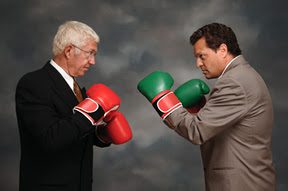It is no secret that the multiple generations that make up today’s workforce think and act differently. Imagine this scenario: A manager holds a meeting with three members of his or her team. One is a member Generation Y, the other of Generation X, and the team is rounded out with a baby boomer.
The leader asks the three to conduct research to solve a challenging business problem. The baby boomer proceeds to the company library in pursuit of this mission; the Gen X member to Google; and the Gen Y begins his search with what feels most natural — Facebook, Twitter and LinkedIn.
Each team member, through their individual research, finds a number of plausible solutions for the business problem. Each brings a unique perspective to this process and all three operate from varying methods. But, all the same, a divide is clear in how they learn and approach new information.
Beneath each generational difference is a challenge for the chief learning officer. How can learning organizations leverage generational divides to create more effective and collaborative training programs?
Take how generations perceive social recognition as a prime example. “What we tend to see is that younger employees — Gen Y employees — are much more concerned about relative rewards and recognition rather than absolute rewards and recognition,” said Brian Kropp, managing director at the Corporate Executive Board, a corporate research consultancy.
What this means, according to Kropp, is that younger generations are more concerned with understanding where they stand relative to their peers. Older employees, on the contrary, are concerned about their personal performance in relation to their own benchmarks and goals.
Consider this example: A group of employees is faced with two options. They could either be presented with a 10 percent raise in compensation and not know the raise received by anyone else, or they could each receive a 5 percent raise and know that everybody else got a raise at a rate of 3 percent.
“What you tend to find is the employees in their mid-30s and above pretty predominately say they would opt for the 10 percent raise,” Kropp said. “Employees in their 20s, it’s about 50-50.”
Part of the reasoning for this might be as simple as the environment each generation grew up in. Kropp said the younger generations — those who are slowly taking over corporate America — grew up in an environment where being socially recognized for accomplishments was a major norm, whereas during the time most baby boomers grew up, it was not. The effect the Internet and social media have had on ideas of privacy, openness and sharing is also a reason why younger workers place more value on social recognition.
“There’s a shift,” Kropp said. “People in Gen Y that are coming into the workforce tended to grow up in an environment where recognition was incredibly important to them as kids and lavished on them.”
As the younger workforce continues to influence the way work gets done, it’s becoming increasingly important for CLOs to recognize these behavioral shifts, and adapt the way learning programs are tailored and implemented. Recognizing that younger generations place relative recognition at a premium might mean crafting a learning strategy that places emphasis on tactics that frame learning as an open, visibly rewarding experience — rather than a closely held practice, focused strictly on individual learning.
Kropp said this generational development is an opportunity for CLOs to integrate more interactive and digital learning structures to cater to younger employees’ needs while promoting collaboration with older workers. “From a CLO perspective, I think that is a huge opportunity to get them [to] play in,” he said.
Game On
David Reisner, manager of technology solutions for performance management consultancy ITAGroup, said that because video games now influence mainstream culture, they’re growing into proven learning tools. They play well for training the new workforce on two fronts, he said — they promote collaboration of different generations and they embrace the recognition needs of younger employees.
“Games really do a good job of mapping out all the various steps and progress that a person needs to accomplish those big goals,” Reisner said.
Games also make training more fun and engaging. As Jeanne Meister and Karie Willyerd write in their book, The 2020 Workplace: How Innovative Companies Attract, Develop, and Keep Tomorrow’s Employees Today, at least 80 percent of corporate learning will eventually come from what they refer to as “participatory learning.”
To start, Meister and Willyerd suggest adding participatory elements to more traditional learning methods. This, they say, can help CLOs assess a group’s cultural readiness in transitioning to more game-like learning, where visual recognition is predominant.
Reisner said such a diversion would be welcomed by employees at first. “We could all relate to sitting in a classroom during a course, when you shift from the lecture and you break up into table groups,” he said. “The energy changes in the room when that happens.”
But sooner or later, as Meister and Willyerd’s book suggests, CLOs are going to have to transition the bulk of their learning toward more social and participatory platforms. Games, whether they are in the form of video or in-person, team-based activities, have the social elements that will be required of future learning.
According to Reisner, making training more socially engaging through games and social media not only makes training more relevant to younger workers, but it fills a void older generations have been mending all along.
“A lot of people have spent a lot of time by themselves looking at their training programs … but at the end of the day, they are probably going to find a friend or somebody to work with [anyway],” he said. “People are already looking for some kind of social connection at these [training programs] that they’re going through.”
Frank Kalman is an associate editor of Chief Learning Office magazine. He can be reached at fkalman@CLOmedia.com.















